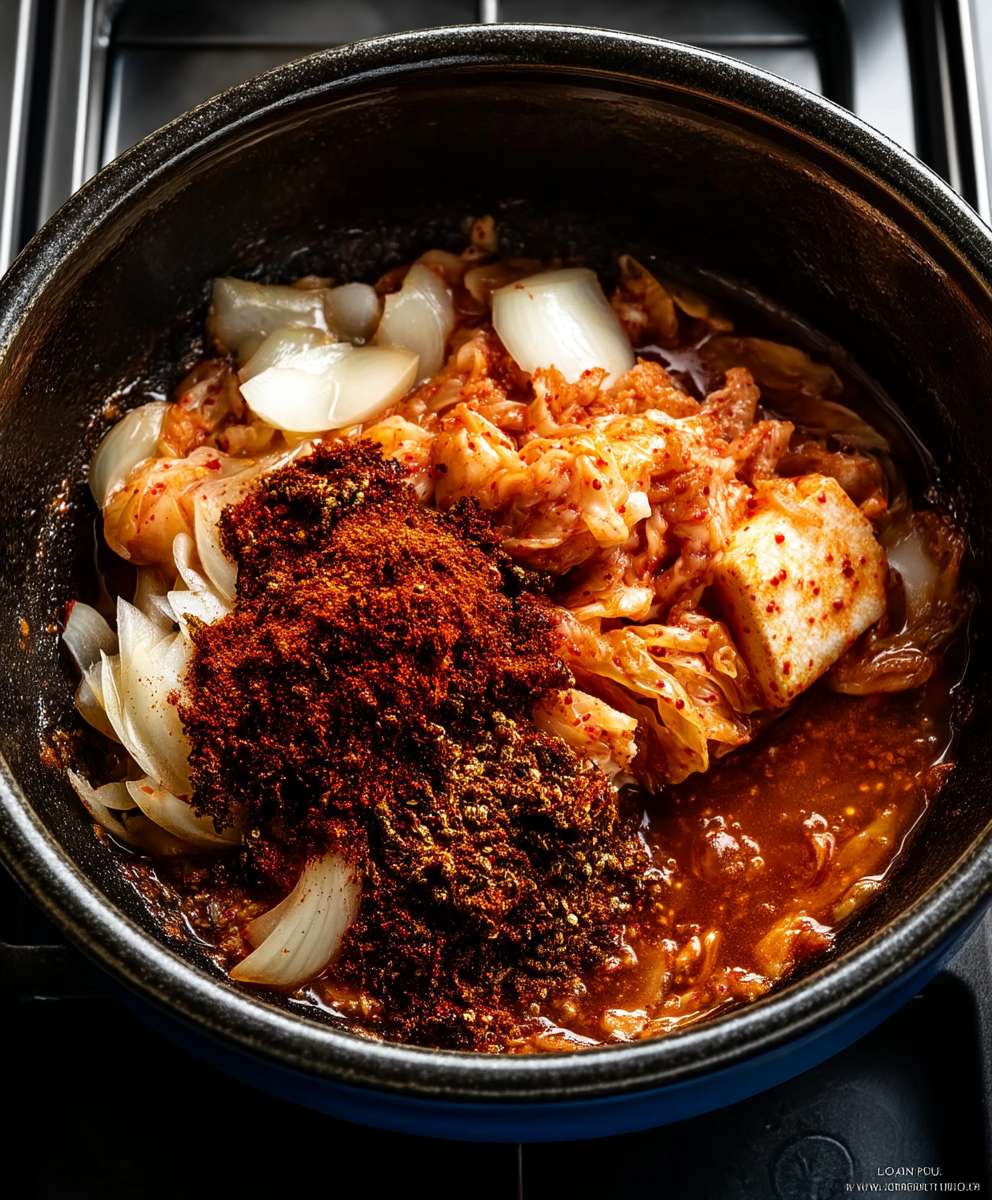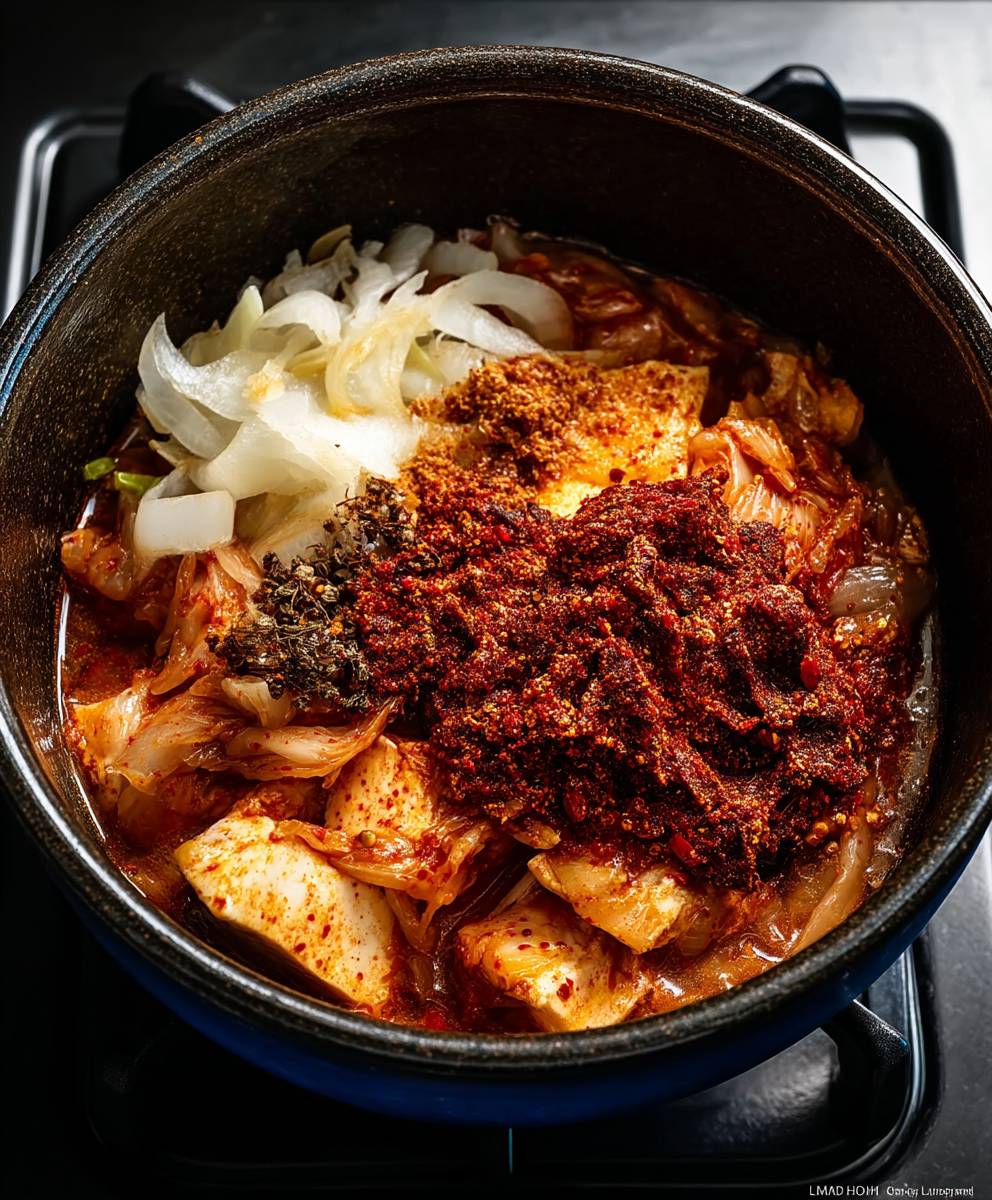Spicy Kimchi Soft Tofu, or Soondubu Jjigae, is a dish that explodes with flavor and comfort in every spoonful. Imagine a bubbling cauldron of fiery broth, silken tofu melting in your mouth, and the tangy kick of kimchi dancing on your tongue. It’s a culinary experience that’s both deeply satisfying and incredibly easy to make at home!
This vibrant stew has deep roots in Korean cuisine, evolving from humble beginnings to become a beloved staple. While the exact origins are debated, many believe Soondubu Jjigae gained popularity as a nutritious and affordable meal, especially during colder months. The use of soft tofu, or “soondubu,” lends a unique texture that distinguishes it from other Korean stews.
What makes Spicy Kimchi Soft Tofu so irresistible? It’s the perfect balance of spicy, savory, and umami flavors. The kimchi adds a delightful sourness and depth, while the gochujang (Korean chili paste) provides the signature heat. The soft tofu offers a creamy contrast to the robust broth, creating a symphony of textures that will leave you craving more. Beyond the incredible taste, this dish is also incredibly versatile. You can customize it with your favorite proteins and vegetables, making it a quick and healthy weeknight meal. So, are you ready to embark on a culinary adventure and discover the magic of Soondubu Jjigae?
Ingredients:
- 1 tablespoon sesame oil
- 1/2 cup chopped kimchi, plus 2 tablespoons kimchi juice
- 1/2 cup chopped onion
- 2 cloves garlic, minced
- 1 teaspoon gochugaru (Korean chili powder), adjust to taste
- 1/2 teaspoon gochujang (Korean chili paste), adjust to taste
- 4 cups chicken or vegetable broth
- 1 package (14-16 ounces) silken tofu, drained and cut into 1-inch cubes
- 1/4 cup soy sauce
- 1 tablespoon fish sauce (optional, but recommended)
- 1 teaspoon sugar
- 1/2 teaspoon ground black pepper
- 1 green onion, thinly sliced, for garnish
- 1 egg per serving (optional)
- Cooked rice, for serving
Preparing the Base:
- First, let’s get our flavor base going! In a medium pot or Dutch oven, heat the sesame oil over medium heat. Make sure the pot is large enough to hold all the ingredients comfortably.
- Add the chopped kimchi and onion to the pot. Sauté for about 5-7 minutes, stirring occasionally, until the onion is softened and the kimchi starts to caramelize slightly. This step is crucial for developing a deep, rich flavor. Don’t rush it!
- Next, add the minced garlic, gochugaru, and gochujang to the pot. Stir well to combine with the kimchi and onion. Cook for another minute or two, until fragrant. Be careful not to burn the garlic. The gochugaru and gochujang are what give this dish its signature spicy kick, so adjust the amounts to your liking. If you’re sensitive to spice, start with less and add more later if needed.
Building the Stew:
- Now, it’s time to add the broth. Pour the chicken or vegetable broth into the pot. Bring the mixture to a boil, then reduce the heat to a simmer.
- Gently add the silken tofu cubes to the pot. Be careful not to break them up too much. Silken tofu is very delicate, so handle it with care.
- Stir in the soy sauce, fish sauce (if using), sugar, and black pepper. The fish sauce adds a wonderful umami depth to the stew, but it’s optional if you prefer a vegetarian version.
- Add the kimchi juice. This will enhance the kimchi flavor and add a bit of tanginess to the stew.
- Simmer the stew for at least 15-20 minutes, or longer if you have time. This allows the flavors to meld together and the tofu to absorb the broth. The longer it simmers, the better it tastes!
Serving and Enjoying:
- While the stew is simmering, cook your rice according to package directions. I prefer short-grain rice for this dish, but any type of rice will work.
- Just before serving, crack an egg into each serving bowl (optional). The hot stew will cook the egg slightly, creating a creamy and delicious addition. If you’re concerned about raw eggs, you can cook the egg separately in a small pan and then add it to the bowl.
- Ladle the spicy kimchi soft tofu stew over the cooked rice.
- Garnish with thinly sliced green onions.
- Serve immediately and enjoy! This stew is best enjoyed hot, straight from the pot.
Tips and Variations:
- Spice Level: Adjust the amount of gochugaru and gochujang to your liking. If you want it extra spicy, add a pinch of cayenne pepper or a few slices of fresh chili peppers.
- Protein: You can add other proteins to this stew, such as pork belly, beef, or seafood. If using meat, brown it in the pot before adding the kimchi and onion.
- Vegetables: Feel free to add other vegetables to the stew, such as mushrooms, zucchini, or spinach. Add them along with the tofu.
- Tofu Type: While silken tofu is traditionally used in this dish, you can also use soft or medium-firm tofu. Just be aware that the texture will be different. If using firmer tofu, you may want to press it first to remove excess water.
- Broth: Chicken broth and vegetable broth are both great options for this stew. You can also use dashi, a Japanese soup stock made from kombu (dried kelp) and bonito flakes.
- Vegan Option: To make this stew vegan, omit the fish sauce and use vegetable broth.
- Make Ahead: This stew can be made ahead of time and stored in the refrigerator for up to 3 days. The flavors will actually deepen as it sits. Reheat gently on the stovetop before serving.
- Freezing: While you can freeze this stew, the texture of the tofu may change slightly. If you do freeze it, thaw it completely before reheating.
- Serving Suggestions: Serve this stew with a variety of Korean side dishes (banchan), such as kimchi, pickled vegetables, and seasoned seaweed.
Detailed Ingredient Information:
- Sesame Oil: Use toasted sesame oil for the best flavor. It adds a nutty aroma and enhances the overall taste of the stew.
- Kimchi: Use well-fermented kimchi for the most authentic flavor. The older the kimchi, the more sour and flavorful it will be. You can find kimchi at most Asian grocery stores or online.
- Onion: Yellow or white onions work well in this recipe.
- Garlic: Freshly minced garlic is always best.
- Gochugaru: This is Korean chili powder, made from dried red chili peppers. It has a slightly sweet and smoky flavor. You can find it at most Asian grocery stores or online.
- Gochujang: This is Korean chili paste, made from fermented red chili peppers, glutinous rice, and soybeans. It has a spicy, savory, and slightly sweet flavor. You can find it at most Asian grocery stores or online.
- Broth: Chicken or vegetable broth can be used. If you’re using store-bought broth, choose a low-sodium option.
- Silken Tofu: This is a very soft and delicate type of tofu. It’s best to handle it gently to avoid breaking it up.
- Soy Sauce: Use regular soy sauce or low-sodium soy sauce.
- Fish Sauce: This adds a salty and umami flavor to the stew. If you’re not a fan of fish sauce, you can omit it.
- Sugar: A small amount of sugar helps to balance the flavors of the stew.
- Black Pepper: Freshly ground black pepper is always best.
- Green Onion: This is used as a garnish and adds a fresh, slightly oniony flavor.
- Egg: This is optional, but it adds a creamy and delicious element to the stew.
- Rice: Cooked rice is served as a base for the stew.
Troubleshooting:
- Stew is too spicy: Add a little bit of sugar or honey to balance the flavors. You can also add more broth to dilute the spice.
- Stew is not spicy enough: Add more gochugaru or gochujang. You can also add a pinch of cayenne pepper or a few slices of fresh chili peppers.
- Stew is too salty: Add more broth or water to dilute the saltiness.
- Stew is too bland: Add more soy sauce, fish sauce, or gochujang. You can also add a pinch of salt or MSG.
- Tofu is breaking apart: Be gentle when handling the tofu. You can also use a firmer type of tofu.
This Spicy Kimchi Soft Tofu stew is a comforting and flavorful dish that’s perfect for a cold day. It’s also a great way to use up leftover kimchi. I hope you enjoy it!

Conclusion:
This Spicy Kimchi Soft Tofu recipe isn’t just another dish; it’s a flavor explosion waiting to happen in your kitchen! I truly believe it’s a must-try for anyone who loves bold flavors, comforting textures, and a dish that’s surprisingly simple to make. The combination of the creamy, melt-in-your-mouth soft tofu with the fiery, fermented kimchi creates a symphony of taste that will leave you craving more. It’s the perfect balance of spicy, savory, and slightly tangy, making it an incredibly satisfying meal any time of day.
But why is this particular recipe so special? It’s all about the ease and the incredible depth of flavor you achieve with minimal effort. Forget spending hours in the kitchen; this dish comes together in under 30 minutes, making it ideal for busy weeknights or when you’re simply craving something delicious without the fuss. Plus, the ingredients are readily available at most grocery stores, so you don’t have to hunt down obscure items.
Beyond the simplicity and flavor, this Spicy Kimchi Soft Tofu is incredibly versatile. Serve it hot, straight from the pot, as a comforting stew on a chilly evening. I personally love topping it with a fried egg for extra richness and protein the runny yolk mingling with the spicy broth is pure heaven! You could also add some thinly sliced scallions for a fresh, vibrant garnish.
Looking for variations? Feel free to experiment! Add some sliced mushrooms for an earthy note, or throw in some pork belly for a heartier meal. If you’re not a fan of pork, shrimp or beef work just as well. For a vegetarian option, consider adding some extra vegetables like zucchini or bell peppers. And if you’re feeling adventurous, try adding a dollop of gochujang (Korean chili paste) for an extra kick of heat.
Here are some of my favorite serving suggestions:
Serving Suggestions:
- Classic Comfort: Serve hot with a bowl of steamed rice and a side of kimchi.
- Egg-cellent Addition: Top with a fried egg for added richness and protein.
- Noodle Time: Toss with cooked udon or ramen noodles for a heartier meal.
- Veggie Boost: Add sliced mushrooms, zucchini, or bell peppers for extra nutrients.
- Spicy Upgrade: Add a dollop of gochujang for an extra kick of heat.
I’m genuinely excited for you to try this recipe. It’s become a staple in my own kitchen, and I know it has the potential to become one of your favorites too. The beauty of this dish lies in its adaptability feel free to adjust the spice level and ingredients to suit your own preferences. Don’t be afraid to get creative and make it your own!
So, what are you waiting for? Gather your ingredients, put on some music, and get ready to experience the deliciousness of this Spicy Kimchi Soft Tofu. I’m confident you’ll love it as much as I do.
And finally, I’d absolutely love to hear about your experience! Once you’ve tried the recipe, please come back and share your thoughts in the comments below. Let me know what variations you tried, what you loved, and what you might do differently next time. Your feedback is invaluable, and it helps me continue to create and share recipes that you’ll enjoy. Happy cooking!
Spicy Kimchi Soft Tofu: A Flavorful and Easy Recipe
A comforting and spicy Korean stew featuring soft tofu, kimchi, and a flavorful broth. Perfect for a cold day!
Ingredients
- 1 tablespoon sesame oil
- 1/2 cup chopped kimchi, plus 2 tablespoons kimchi juice
- 1/2 cup chopped onion
- 2 cloves garlic, minced
- 1 teaspoon gochugaru (Korean chili powder), adjust to taste
- 1/2 teaspoon gochujang (Korean chili paste), adjust to taste
- 4 cups chicken or vegetable broth
- 1 package (14-16 ounces) silken tofu, drained and cut into 1-inch cubes
- 1/4 cup soy sauce
- 1 tablespoon fish sauce (optional, but recommended)
- 1 teaspoon sugar
- 1/2 teaspoon ground black pepper
- 1 green onion, thinly sliced, for garnish
- 1 egg per serving (optional)
- Cooked rice, for serving
Instructions
- In a medium pot or Dutch oven, heat the sesame oil over medium heat.
- Add the chopped kimchi and onion to the pot. Sauté for about 5-7 minutes, stirring occasionally, until the onion is softened and the kimchi starts to caramelize slightly.
- Add the minced garlic, gochugaru, and gochujang to the pot. Stir well to combine with the kimchi and onion. Cook for another minute or two, until fragrant. Be careful not to burn the garlic. Adjust the gochugaru and gochujang to your spice preference.
- Pour the chicken or vegetable broth into the pot. Bring the mixture to a boil, then reduce the heat to a simmer.
- Gently add the silken tofu cubes to the pot. Be careful not to break them up too much.
- Stir in the soy sauce, fish sauce (if using), sugar, and black pepper.
- Add the kimchi juice.
- Simmer the stew for at least 15-20 minutes, or longer if you have time.
- While the stew is simmering, cook your rice according to package directions.
- Just before serving, crack an egg into each serving bowl (optional).
- Ladle the spicy kimchi soft tofu stew over the cooked rice.
- Garnish with thinly sliced green onions.
- Serve immediately and enjoy!
Notes
- Spice Level: Adjust the amount of gochugaru and gochujang to your liking. For extra spice, add cayenne pepper or fresh chili peppers.
- Protein: Add pork belly, beef, or seafood. Brown meat before adding kimchi and onion.
- Vegetables: Add mushrooms, zucchini, or spinach along with the tofu.
- Tofu Type: Use soft or medium-firm tofu if silken isn’t available. Press firmer tofu to remove excess water.
- Broth: Dashi can be used as an alternative broth.
- Vegan Option: Omit fish sauce and use vegetable broth.
- Make Ahead: Store in the refrigerator for up to 3 days. Reheat gently.
- Freezing: Texture of tofu may change. Thaw completely before reheating.
- Serving Suggestions: Serve with Korean side dishes (banchan).
- Stew is too spicy: Add a little bit of sugar or honey to balance the flavors. You can also add more broth to dilute the spice.
- Stew is not spicy enough: Add more gochugaru or gochujang. You can also add a pinch of cayenne pepper or a few slices of fresh chili peppers.
- Stew is too salty: Add more broth or water to dilute the saltiness.
- Stew is too bland: Add more soy sauce, fish sauce, or gochujang. You can also add a pinch of salt or MSG.
- Tofu is breaking apart: Be gentle when handling the tofu. You can also use a firmer type of tofu.






Leave a Comment